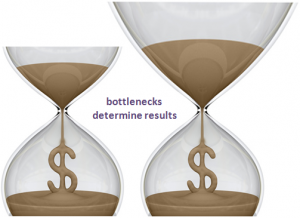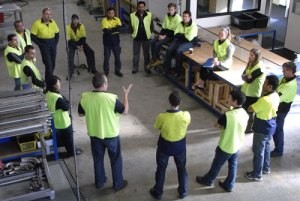A bottleneck is an impediment or a barrier to productivity, efficiency or speed. In both our personal and professional life if we are able to identify the bottleneck, and treat it, life becomes trouble-free. The term bottleneck is an analogy to the shape of a bottle that narrows at the neck. A bottleneck slows down the process of a business operation. Dr. Eliyahu M. Goldratt’s novel “The Goal” is about systems management processes. This book can be used as a case study in operations management, with a focus on the theory of constraints, and how to ease them, and applications of these concepts in real life. The book was released about thirty five years back.
The fundamental premise of the theory of constraints is that organizations can be measured and controlled on three key areas: throughput (amount of material or  items passing through a system or process), operational expense, and inventory. Inventory is all the money that the system has invested in the raw materials used to produce the finished goods, material in the production process (referred to as work-in-progress ), or goods that are in transit. As a result, throughput is the rate at which the system generates money through sales.
items passing through a system or process), operational expense, and inventory. Inventory is all the money that the system has invested in the raw materials used to produce the finished goods, material in the production process (referred to as work-in-progress ), or goods that are in transit. As a result, throughput is the rate at which the system generates money through sales.
For reaching a goal, necessary conditions must first be met. These typically include safety, quality, legal obligations, etc. For most businesses including non-profit organizations, making money is an essential goal, therefore understanding how to make sound financial decisions based on throughput, inventory, and operating expense is a critical requirement.
The term “Herbie” comes from this record-breaking novel. To understanding the process of production we are told the story of Herbie by the protagonist of the novel – Alex Rogo. Herbie is the slowest kid on a hike in his Boy Scout troop. The troop must stay closer enough together so that they can be supervised easily by an adult. They need to get to the campground before it is dark. The speed of the hike is wholly dependent on how fast Herbie moves. The proverb “A chain is only as strong as its weakest link” describes that if one member of a team doesn’t perform well, the whole team fails. The author compares business production to the hiking troop; how to get Herbie to move as fast as he can so that the troop reaches the campground faster. If Herbie’s backpack and other load is distributed among others troopers they can reach their destination faster.
other load is distributed among others troopers they can reach their destination faster.
Alex Rogo manages a production plant owned by UniCo Manufacturing, where everything is always behind schedule and things are looking dire. The book goes on to point out how identifying herbies makes it possible to reduce their impact and how it also helps in yielding a useful tool for measuring and controlling the flow of materials. Alex and his team identify the bottlenecks in their process and immediately begin to implement changes to help increase capacity and speed up production. In response to questions about the logic of using obsolete technology in modern manufacturing, Alex’s team buys in an old machine which they receive for free (which had previously been used at their plant in conjunction with two other machines) in order to increase the capacity of the NCX-10 machine, which had been identified as one of the two bottlenecks. In addition, they identify processes at the heat treat, identified as their second bottleneck, that caused massive delays in their getting product through heat-treat and which had also caused some products to be heat-treated multiple times (to make softer and then harder again) instead of just once or not at all.
The novel goes on to point out that a Herbie can be solved effectively, when each person in organization plays his role effectively. For example, a researcher is supposed to do his research and create an intellectual property. Instead, if he starts doing bookkeeping, he will only create another Herbie. Effective role playing solves many technical and emotional problems in business firms.
For smoothening the process people need to identify the system’s constraints, make strategies to exploit the system’s constraints, unanimously solve the problem to elevate the system’s constraint; the team to needs to go exactly to the point where the system has been broken. The constraints occur in equipments, people and policy. In the book, they discover they are running their manufacturing plant at 80% capacity. That means 20% of the time, they have machines and people just sitting there doing nothing. So they tell their sales manager to get them 20% more work. Ideal mind is devil’s workshop. Once people get used to sit ideal, changing their mindset becomes very difficult.
Most important message: when there is no Herbie in the business, when things are going smooth, finding one will only create many others. The point is not to find the herbie in crisis, but always to keep a watch and look out for him. Changes never take place in the moments of crisis. Crisis is an indication of unidentified flaws in the system. As with treating the symptoms without the underlying bug can never bring effective change.
The centre theme of the book “The Goal” is that you shouldn’t let your business and processes control you and lead you. Instead, you should constantly disparage and review your processes and not settling for any bottlenecks or sticking points. One more major theme is that businesses want to earn profit. The way to do this is not to create as much as possible, but instead to run as efficiently as possible.












































